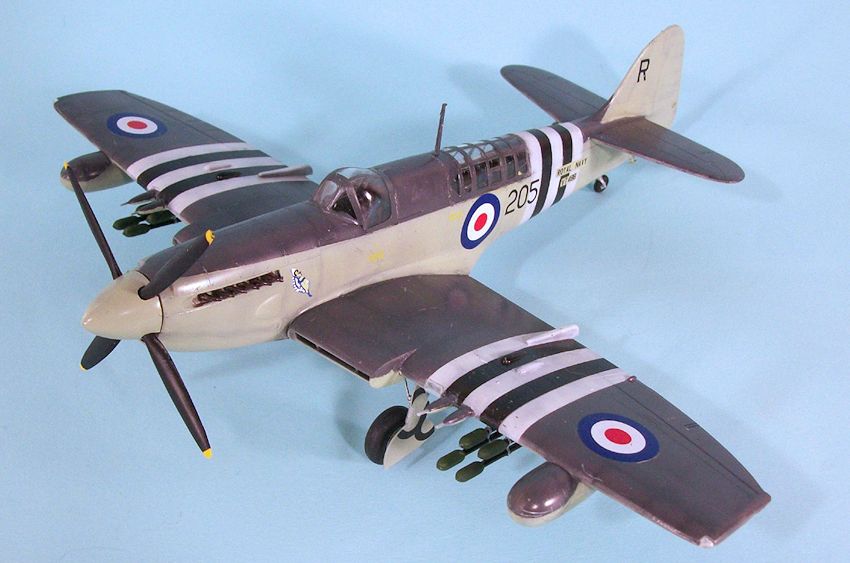
Special Hobby 1/48 Firefly Mk. 4/5 'Korean War'
| KIT #: | 48136 |
| PRICE: | $57.00 SRP |
| DECALS: | Four options |
| REVIEWER: | Tom Cleaver |
| NOTES: | Short run kit |

| HISTORY |
During the last year of the Second World War, the Fairey Firefly F.R.I had proven itself the best British designed carrier strike aircraft used in the conflict. With the end of the war and the need to get rid of the U.S. carrier aircraft provided under lend lease, the Firefly acquired new importance as it became the only carrier based strike aircraft available to the Fleet Air Arm.
After the design and production of the Firefly
III, a Mk.I airframe with a Griffon 61 engine enclosed in an annular radiator
that made the aircraft directionally unstable, a more extensive redesign around
the more powerful engine was undertaken. The radiators were removed to the
leading edges of the wing, which
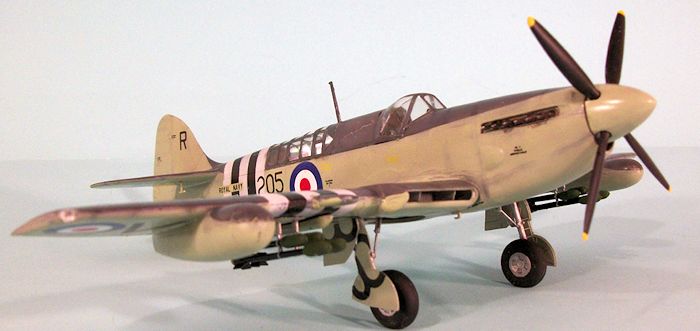 allowed a much cleaner engine cowling, with
benefit to both performance and handling. Trials with the original Firefly III
airframe with the new cowling and radiator installation began in 1944, with the
engine upgraded to a Griffon 72. Three more Mk.I airframes were used in the
development program, which resulted in the Firefly IV.
allowed a much cleaner engine cowling, with
benefit to both performance and handling. Trials with the original Firefly III
airframe with the new cowling and radiator installation began in 1944, with the
engine upgraded to a Griffon 72. Three more Mk.I airframes were used in the
development program, which resulted in the Firefly IV.
The new version used the Griffon 74, which proved 2,100 h.p. at sea level, compared with the 1,735 h.p. available from the Griffon II and XII used in the Firefly I. This allowed the maximum weight to be raised 1,000 pounds above that of the Mk.I, and still provide a 40 m.p.h. increase in maximum speed, to 345 m.p.h. at 12,500 feet. The wingtips were clipped to improve the roll rate, though the total wing area remained the same with the increase at the wing roots for the radiators, and the ASH radar used by the N.F.I was located in a small nacelle under the starboard wing, with an auxiliary fuel tank of similar size and shape under the port wing to preserve symmetry. Flight tests in 1945 revealed a need for a 4 blade prop to absorb the increased power and an enlarged vertical fin and rudder to preserve stability.
A reallocation of contracts for Firefly Is in August 1945 allowed for initial production of 30 F.R. Mk.IV and 23 N.F. Mk.IV Fireflies, with a further 67 F.R. Mk.IVs ordered in November for a total production of 120 aircraft for the Fleet Air Arm. In May, 1946, the Royal Netherlands Navy ordered 40 F.r. Mk.IVs.
While the first flight of a production Firefly IV came on May 25, 1945, the wind down of the war resulted in the first Mk.IV being delivered in September 1946, with the first two fleet squadrons 810 and 825 becoming operational in September 1947.
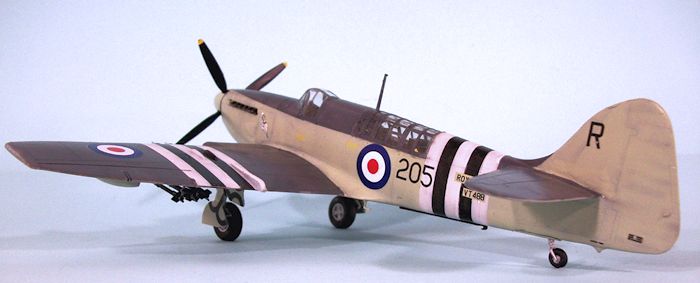 While the Firefly IV joined the earlier
Firefly Is in fleet squadrons in the fighter reconnaissance role, the visually
virtually identical Firefly Mk. 5 became a "universal" airframe which could be
used in either the fighter reconnaissance, night fighter, or anti submarine
role. First flight of the Firefly Mk. 5 came on December 12, 1947. An
outstanding contract for 117 Firefly IVs was modified to cover initial
production of the Firefly 5, with subsequent production of 52, 103 and 66
aircraft beginning in May 1948; Dutch purchase of an additional 14 Firefly 5s
brought total production to 352, with delivery to the FAA beginning in January
1948 and ending in May 1950.
While the Firefly IV joined the earlier
Firefly Is in fleet squadrons in the fighter reconnaissance role, the visually
virtually identical Firefly Mk. 5 became a "universal" airframe which could be
used in either the fighter reconnaissance, night fighter, or anti submarine
role. First flight of the Firefly Mk. 5 came on December 12, 1947. An
outstanding contract for 117 Firefly IVs was modified to cover initial
production of the Firefly 5, with subsequent production of 52, 103 and 66
aircraft beginning in May 1948; Dutch purchase of an additional 14 Firefly 5s
brought total production to 352, with delivery to the FAA beginning in January
1948 and ending in May 1950.
FAA squadrons using the Firefly I began re equipping with the Firefly 5 with 815 squadron taking the first on charge in late January 1948. No. 825 Squadron took on seven Firefly 5s in addition to their 24 Firefly 4s, and operated from HMCS "Magnificent" as an RCN squadron. 816 and 817 Squadrons, both completely equipped with Firefly 5s, served with the Royal Australian Navy aboard HMAS "Sydney."
The Firefly's major combat operations came with the outbreak of the Korean War. The first Firefly 4 squadron to see combat was 810, aboard HMS "Theseus", which relieved "Triumph" in October 1950. The Firefly 4s and 5s operated from the light fleet carriers in Korean waters primarily flew close support missions for the ground troops. This was not a mission originally envisaged for the aircraft, but the ability of the Firefly 4s and 5s to carry significant underwing ordnance loads due to the extra power of the Griffon 74 allowed a combat load of 2,000 lbs. per aircraft. While this was light compared to such U.S. types as the Corsair and Skyraider, it was a significant load to be taken off one of the small British light carriers, without aid of a catapult. The aircraft was so reliable it could fly up to three sorties per day per aircraft from a carrier, with a squadron of 26 aircraft, often in extremely adverse weather.
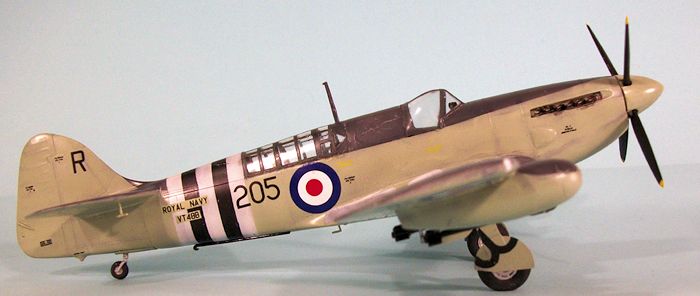 The record for individual missions during a
Korean deployment went to LT J.F.K. “Sean” McGrail of 821 Squadron, who flew 118
missions from HMS “Glory” between November 1952 and May 1953. The record number
of 123 total sorties flown in a single day by H.M.S. "Ocean" on May 17, 1952,
included 47 flown by 825 Squadron’s Fireflies. At the end of July, 1952, MiG 15s
first attacked the unit’s aircraft, causing one Firefly to force land. Between
May and the end of October 1952, 825 Squadron flew 1,907 sorties in 3,243 flying
hours; in 1,948 deck landings, there were only four accidents. 16,868 rockets
were fired and 96,500 pounds of bombs dropped. For this performance, 825 was
awarded the Body Trophy for 1952.
The record for individual missions during a
Korean deployment went to LT J.F.K. “Sean” McGrail of 821 Squadron, who flew 118
missions from HMS “Glory” between November 1952 and May 1953. The record number
of 123 total sorties flown in a single day by H.M.S. "Ocean" on May 17, 1952,
included 47 flown by 825 Squadron’s Fireflies. At the end of July, 1952, MiG 15s
first attacked the unit’s aircraft, causing one Firefly to force land. Between
May and the end of October 1952, 825 Squadron flew 1,907 sorties in 3,243 flying
hours; in 1,948 deck landings, there were only four accidents. 16,868 rockets
were fired and 96,500 pounds of bombs dropped. For this performance, 825 was
awarded the Body Trophy for 1952.
The end of the war in Korea saw the end of combat service for the Firefly, which had seen the units sent to Korea also used while enroute to and from the war zone for strikes in Malaya in support of Operation Firedog, the anti terrorist war which had begun in 1948. The active first line service of the Firefly with the Royal Navy ended in 1956, though Fireflies modified as trainers, tugs and targets operated until 1964.
The Firefly was not a great warplane, but it was a thoroughgoing workhorse with extraordinary versatility and tractability, which had been able to take on missions unforeseen at the time of its initial design in 1939.
| THE KIT |
For a very long time, the only kit of the
Korean-era Firefly was in 1/72, released by Airfix 50 years ago. In the 1990s,
PP Aeroparts released a vacuform 1/48 Firefly 4/5, which was later remastered in
resin. This kit has not been available since around 2005. Grand Phoenix released
a Firefly I around 2003, with plans to release a Firefly 4/5 that never came to
fruition. Starting two years ago, Special Hobby has released the Firefly I,
Firefly 4/5 and Firefly AS7 and U Mk.8 drone
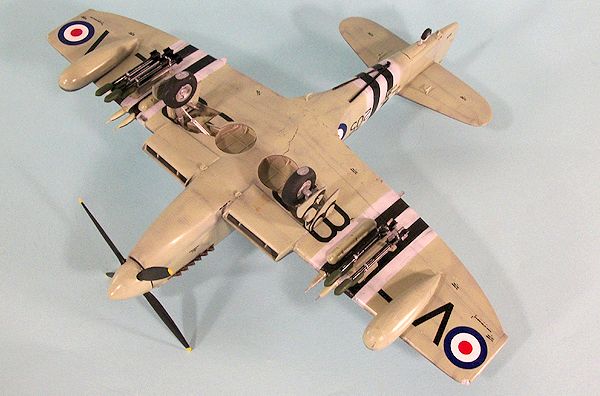 in various boxings covering
different users of the airplanes. These look like they could have been based on
the Grand Phoenix kit, at least as regards the Firefly I, but if so, the kit was
cleaned up and certain failings like the prop spinner have been corrected. The
Firefly 4/5 has been released in “Korean War” service, which involves airplanes
of the Royal Navy and Royal Australian Navy in Korea, and in “foreign service”
which includes Dutch and Canadian markings. The Korean kit provides markings for
810, 812 and 821 Squadrons, FAA, and 817 Squadron RAN. The decals are quite thin
and a modeler is well-advised to airbrush some Liquid Decal Film onto them
before using to keep them from folding up on themselves.
in various boxings covering
different users of the airplanes. These look like they could have been based on
the Grand Phoenix kit, at least as regards the Firefly I, but if so, the kit was
cleaned up and certain failings like the prop spinner have been corrected. The
Firefly 4/5 has been released in “Korean War” service, which involves airplanes
of the Royal Navy and Royal Australian Navy in Korea, and in “foreign service”
which includes Dutch and Canadian markings. The Korean kit provides markings for
810, 812 and 821 Squadrons, FAA, and 817 Squadron RAN. The decals are quite thin
and a modeler is well-advised to airbrush some Liquid Decal Film onto them
before using to keep them from folding up on themselves.
The kits are typical Special Hobby. They feature nice surface detail and “detailed-enough” cockpits, with a variety of underwing ordnance. As is usual with Special Hobby, fit can be problematic and a modeler is well advised to “test fit four times before gluing once.” The kits come with both the rocket rails and mounting plate associated with the Firefly I and the later zero-length “double load” RPs used by the Firefly 4/5. The late version bomb racks are provided, but no bombs. The canopies are a bit thick but clear, and cannot be posed open.
| CONSTRUCTION |
I broke the construction process down to two major sub-assemblies, the fuselage and wing.
Assembly of the fuselage began with assembly
and finish of the cockpits. These were painted overall flat black, so I
assembled them before painting, then highlighted detail with a silver pencil. I
used the kit decal
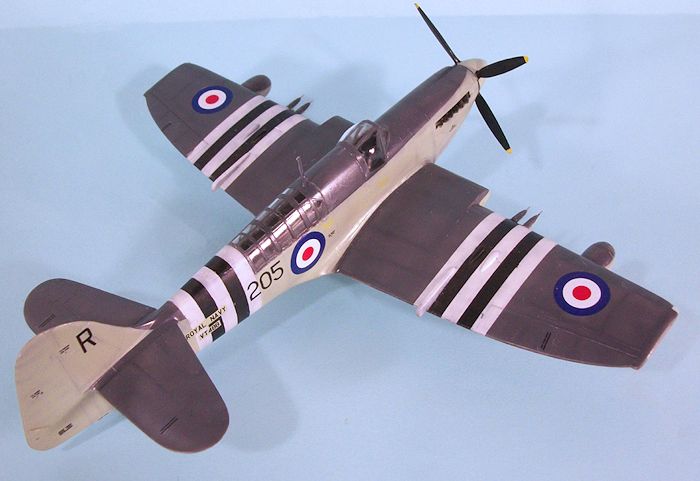 for the instrument panel. The seats were Badelite, so were
painted Tamiya “Hull Red”. I made seat belts from lead foil saved from wine
bottles back when they came with that. The fuselage was then assembled. It was
obvious Mr. Surfacer was going to be used, but I waited until I had the model
fully assembled before doing that.
for the instrument panel. The seats were Badelite, so were
painted Tamiya “Hull Red”. I made seat belts from lead foil saved from wine
bottles back when they came with that. The fuselage was then assembled. It was
obvious Mr. Surfacer was going to be used, but I waited until I had the model
fully assembled before doing that.
Assembly of the wing started with attaching the resin wheel well to the lower wing surface. I test fitted the entire wing and discovered this resin block would fit with only a bit of sanding-down fore and aft. I superglued it in position, then attached up upper wings. I then assembled the radiator housings and glued them to the wing. More Mr. Surfacer was going to be put to use. I then assembled the wing pods and the horizontal stabilizers.
With careful fitting, the wing attached to the fuselage. I then attached the horizontal stabilizers. After allowing everything to set up overnight, I applied Mr. Surfacer to every joint and proceeded to sand down, re-apply, sand some more, then rescribe detail. When that was done, I attached the wing pods and applied Mr. Surfacer around their bases and sanded that smooth.
| COLORS & MARKINGS |
I used Tamiya tape to mask the canopies, a
tedious process. With that done, I pre-shaded the model with Tamiya NATO Black.
I then masked the areas of the black stripes and painted the white stripes, then
masked them. I painted the upper surface with Tamiya XF-24 Dark Grey, and
masked that off. I painted the lower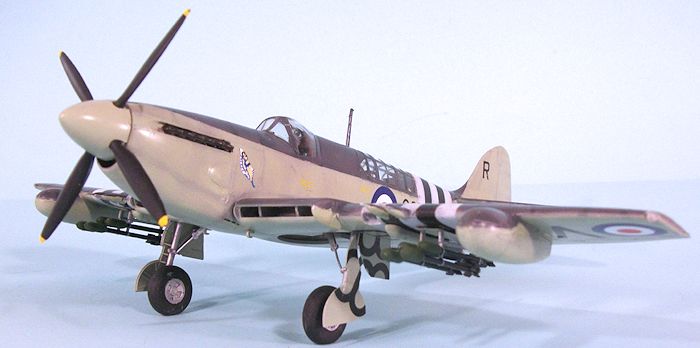 surfaces with Xtracrylix “Sky.” I unmasked
the camouflage and gave the model an overall coat of Future.
surfaces with Xtracrylix “Sky.” I unmasked
the camouflage and gave the model an overall coat of Future.
Having had a bad experience with the kit decals in the Special Hobby Guardian kit, and having heard some horror stories from other modelers about the very thin Special Hobby decals folding up on themselves when being positioned, I had airbrushed the decal sheet with Micro Sol “liquid decal film.” This meant I had to cut the decals closely to minimize carrier film, but the precaution meant they were easy to apply and they went down under an application of Micro-Sol.
I gave the model an overall coat of Xtracrylix “Satin” clear varnish. I then unmasked the canopies. I attached the landing gear, radio mast, catapult spools and other antennas, and prop. I also attached the underwing rockets.
| CONCLUSIONS |
A much easier kit (and lots less expensive) than the PP Aeroparts vacuform Firefly I did some 20 years ago. I’ve always liked the Firefly 4/5, and it is nice to have one in the collection now. Not a kit for beginners, but if you have some experience with limited-run kits, it won’t present any problems you can’t deal with.
October 2015
Review kit courtesy of my wallet, a sale, and
you good folks buying my books.
If you would like your product reviewed fairly and fairly
quickly, please
contact
the editor or see other details in the
Note to
Contributors.